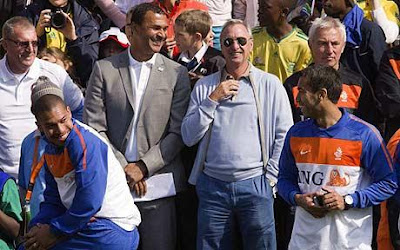One of the highlights of the Arles photography festival is this retrospective of portraits of Mick Jagger, perhaps the world’s most photographed performer. Curator Francois Hebel has pulled together images from his long career, taken by the leading portraitists of our time. Jagger has only ever consented to portrait sessions with the best in the field.
Here, (above, 1966) Jean Marie Perier, former lover of Francoise Hardy and France’s answer to David Bailey, captures the singer in a typically nonchalant pose: “We were on tour in France,” he recalls. “After the show, Mick asked me to find a car to go back to Paris because he didn’t want to wait for the train. I took the whole group in the back of my car overnight, arriving at about 6am.
We went straight to my apartment, I made some tea and then I took this picture. It must have been about 8 by then. I spent 12 years of my life with Mick, I’ve been everywhere with him and he let me do everything I wanted. More than anything, I’m grateful he trusted me as he did. He never asked to see a picture before it was printed – a freedom that would be inconceivable with the stars of today.
This weekend, the Arles photography festival takes the pulse of a medium that has never been more vital. France’s celebrated Rencontres d’Arles, perhaps the most important annual photographic event in the world, the 41st edition of which opens in the sun-kissed Provencal town on Saturday 3 July.
Over the years Arles has played host to many of the most significant figures in photography. Ansel Adams, Brassai, André Kertesz, Martin Parr and most recently Nan Goldin have all graced the programme, which comprises exhibitions examining contemporary photographic practice and emerging markets – Argentina this year – as well as themed retrospectives such as a Mick Jagger series. ABOVE: Female Swimmer, 1981, by Ernst Haas
Magnum photographer Ernst Haas is widely acknowledged to be the first to harness the possibilities offered by colour transparency films. “A picture“ he said “is the expression of an impression. If the beautiful were not in us, how would we ever recognise it?”
By Enrique Badulescu, 1989
Mexican Enrique Badulescu was commissioned to photograph Jagger for the Stones’1989 comeback album Steel Wheels.
By Enrique Badulescu, 1989
“I couldn’t believe how effortlessly he moved in front of the camera,” says Badulescu, who used a technique called Polaroid dye transfer, in which the layers of the image are pulled apart during the developing stage. (Work is a triptych.)
By Terry O’Neill, 1974
1974 was a tricky time for the Rolling Stones. The members of the band were living in different countries and Keith Richards’ drug intake was affecting his productivity. Mick Taylor would quit at the end of the year. “But through it all,” says Terry O’Neill, who photographed the band to promote the film Ladies and Gentleman: The Rolling Stones, “Mick worked as hard in the photo shoots as he did on stage. There was never a question of him giving you a hard time.”
By Gered Mankowitz, 1966
“I loved that coat,” says British photographer Gered Mankowitz. “It was a cold autumn evening on the roof of Harley House in Marylebone, where Mick had just bought an apartment. Management wanted a series of the Rolling Stones at home, but they hated the idea of opening their private space up to strangers, particularly at a time when they were getting lots of hostile press. I’d just been on tour with them and they saw me as one of the gang, so I got the go-ahead. Mick was always very sweet to me.”
By Anwar Hussein, 1973
In 1973, the Stones performed at the Stadthalle in Vienna. “Mick and I went to one of Vienna’s stately homes to take a set of photographs,” recalls Anwar Hussein, now photographer to the Royal family. “We walked outside and he asked me to take a couple of pictures with his own little Instamatic. I was using transparency film at the time, which really makes the light sing. He was a joy to photograph, once he relaxed he would pose like a model.”






























